Project Management: Tools, Techniques, and Implementation Report
VerifiedAdded on 2022/12/12
|12
|3247
|55
Report
AI Summary
This report provides a comprehensive overview of project management within an organizational context, using Tesco as a case study. It delves into the significance of various project management tools and techniques, including classical, waterfall, and agile methodologies, emphasizing their role in optimizing resource utilization, assessing risks, and ensuring accurate project estimations. The report outlines the process of planning and implementing projects, detailing the creation of implementation plans, communication strategies with stakeholders, and the importance of project monitoring. Furthermore, it includes an evaluation of the author's project management abilities, identifying strengths and weaknesses, and proposing a self-development plan to enhance performance in managing projects. The report covers critical aspects of project management, from defining project goals to ensuring their successful completion within specified timeframes and budgets.
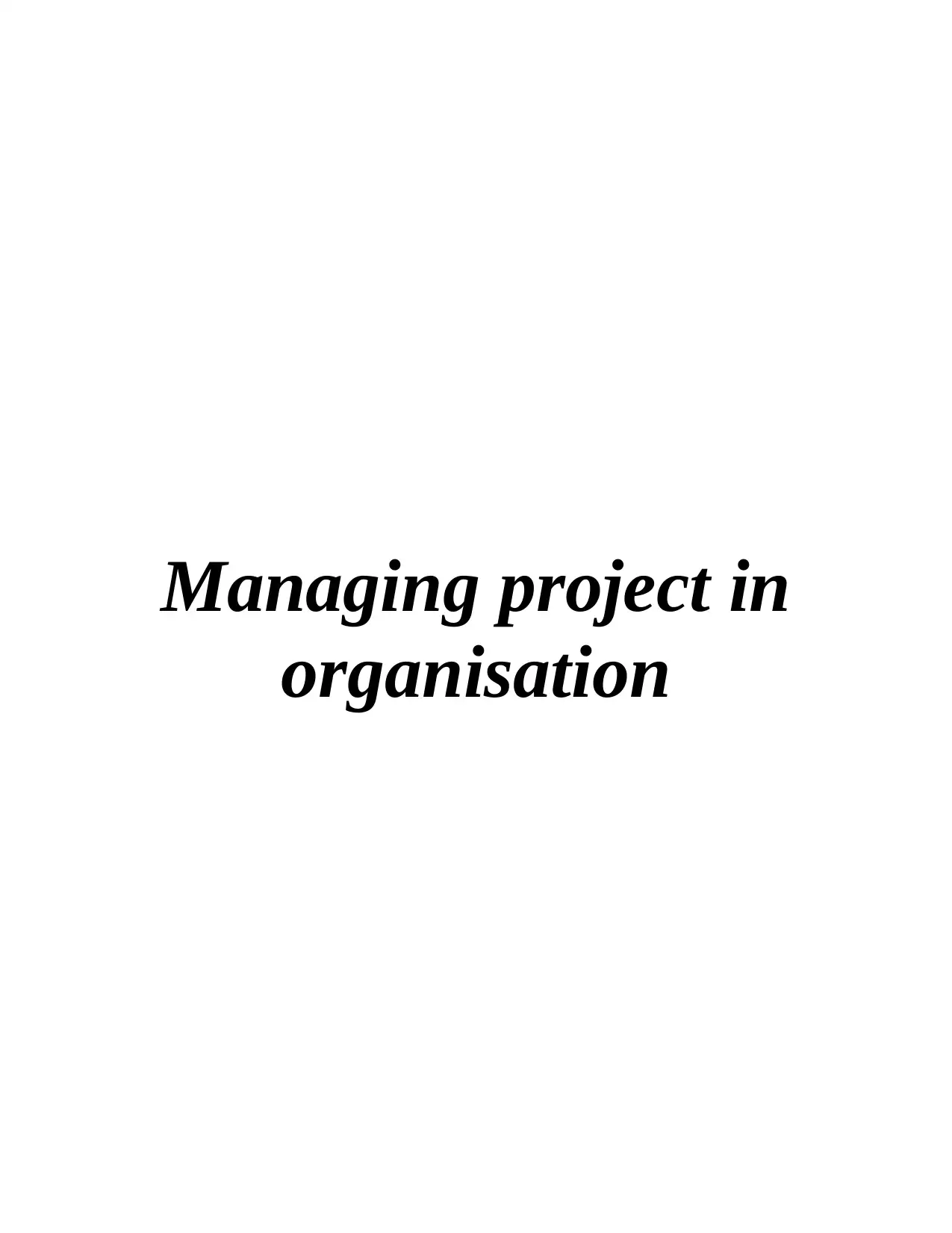
Managing project in
organisation
organisation
Paraphrase This Document
Need a fresh take? Get an instant paraphrase of this document with our AI Paraphraser
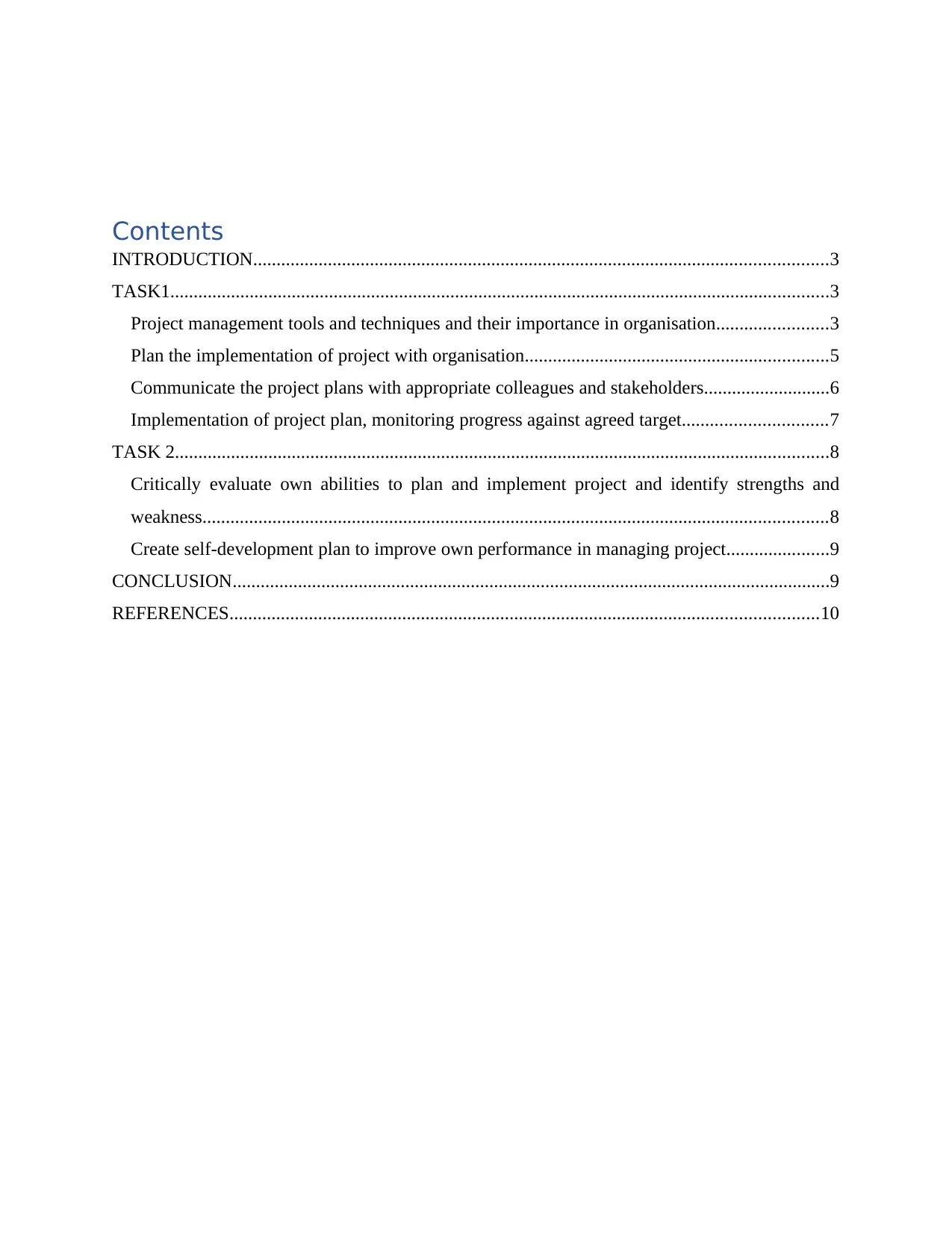
Contents
INTRODUCTION...........................................................................................................................3
TASK1.............................................................................................................................................3
Project management tools and techniques and their importance in organisation........................3
Plan the implementation of project with organisation.................................................................5
Communicate the project plans with appropriate colleagues and stakeholders...........................6
Implementation of project plan, monitoring progress against agreed target...............................7
TASK 2............................................................................................................................................8
Critically evaluate own abilities to plan and implement project and identify strengths and
weakness......................................................................................................................................8
Create self-development plan to improve own performance in managing project......................9
CONCLUSION................................................................................................................................9
REFERENCES..............................................................................................................................10
INTRODUCTION...........................................................................................................................3
TASK1.............................................................................................................................................3
Project management tools and techniques and their importance in organisation........................3
Plan the implementation of project with organisation.................................................................5
Communicate the project plans with appropriate colleagues and stakeholders...........................6
Implementation of project plan, monitoring progress against agreed target...............................7
TASK 2............................................................................................................................................8
Critically evaluate own abilities to plan and implement project and identify strengths and
weakness......................................................................................................................................8
Create self-development plan to improve own performance in managing project......................9
CONCLUSION................................................................................................................................9
REFERENCES..............................................................................................................................10
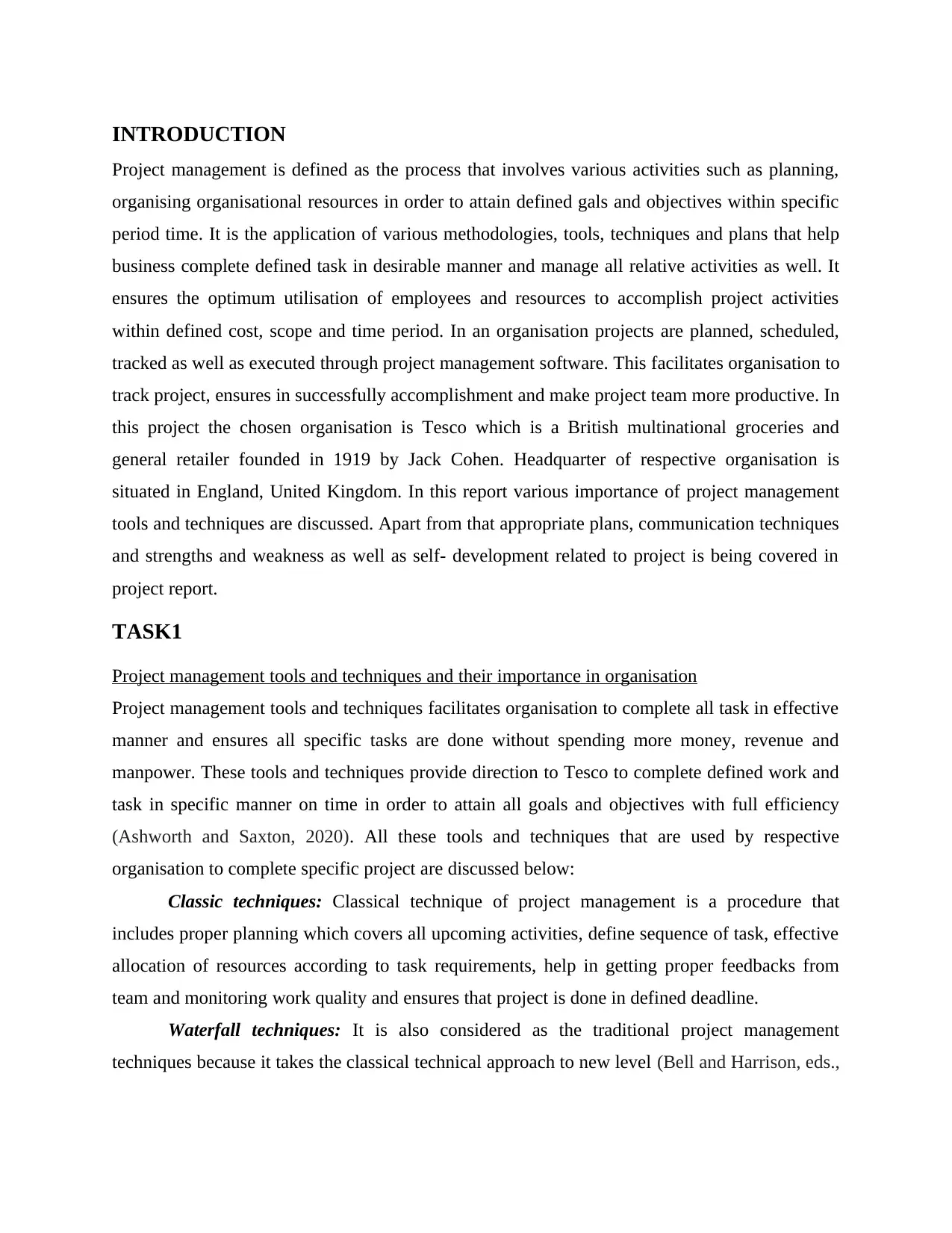
INTRODUCTION
Project management is defined as the process that involves various activities such as planning,
organising organisational resources in order to attain defined gals and objectives within specific
period time. It is the application of various methodologies, tools, techniques and plans that help
business complete defined task in desirable manner and manage all relative activities as well. It
ensures the optimum utilisation of employees and resources to accomplish project activities
within defined cost, scope and time period. In an organisation projects are planned, scheduled,
tracked as well as executed through project management software. This facilitates organisation to
track project, ensures in successfully accomplishment and make project team more productive. In
this project the chosen organisation is Tesco which is a British multinational groceries and
general retailer founded in 1919 by Jack Cohen. Headquarter of respective organisation is
situated in England, United Kingdom. In this report various importance of project management
tools and techniques are discussed. Apart from that appropriate plans, communication techniques
and strengths and weakness as well as self- development related to project is being covered in
project report.
TASK1
Project management tools and techniques and their importance in organisation
Project management tools and techniques facilitates organisation to complete all task in effective
manner and ensures all specific tasks are done without spending more money, revenue and
manpower. These tools and techniques provide direction to Tesco to complete defined work and
task in specific manner on time in order to attain all goals and objectives with full efficiency
(Ashworth and Saxton, 2020). All these tools and techniques that are used by respective
organisation to complete specific project are discussed below:
Classic techniques: Classical technique of project management is a procedure that
includes proper planning which covers all upcoming activities, define sequence of task, effective
allocation of resources according to task requirements, help in getting proper feedbacks from
team and monitoring work quality and ensures that project is done in defined deadline.
Waterfall techniques: It is also considered as the traditional project management
techniques because it takes the classical technical approach to new level (Bell and Harrison, eds.,
Project management is defined as the process that involves various activities such as planning,
organising organisational resources in order to attain defined gals and objectives within specific
period time. It is the application of various methodologies, tools, techniques and plans that help
business complete defined task in desirable manner and manage all relative activities as well. It
ensures the optimum utilisation of employees and resources to accomplish project activities
within defined cost, scope and time period. In an organisation projects are planned, scheduled,
tracked as well as executed through project management software. This facilitates organisation to
track project, ensures in successfully accomplishment and make project team more productive. In
this project the chosen organisation is Tesco which is a British multinational groceries and
general retailer founded in 1919 by Jack Cohen. Headquarter of respective organisation is
situated in England, United Kingdom. In this report various importance of project management
tools and techniques are discussed. Apart from that appropriate plans, communication techniques
and strengths and weakness as well as self- development related to project is being covered in
project report.
TASK1
Project management tools and techniques and their importance in organisation
Project management tools and techniques facilitates organisation to complete all task in effective
manner and ensures all specific tasks are done without spending more money, revenue and
manpower. These tools and techniques provide direction to Tesco to complete defined work and
task in specific manner on time in order to attain all goals and objectives with full efficiency
(Ashworth and Saxton, 2020). All these tools and techniques that are used by respective
organisation to complete specific project are discussed below:
Classic techniques: Classical technique of project management is a procedure that
includes proper planning which covers all upcoming activities, define sequence of task, effective
allocation of resources according to task requirements, help in getting proper feedbacks from
team and monitoring work quality and ensures that project is done in defined deadline.
Waterfall techniques: It is also considered as the traditional project management
techniques because it takes the classical technical approach to new level (Bell and Harrison, eds.,
⊘ This is a preview!⊘
Do you want full access?
Subscribe today to unlock all pages.

Trusted by 1+ million students worldwide
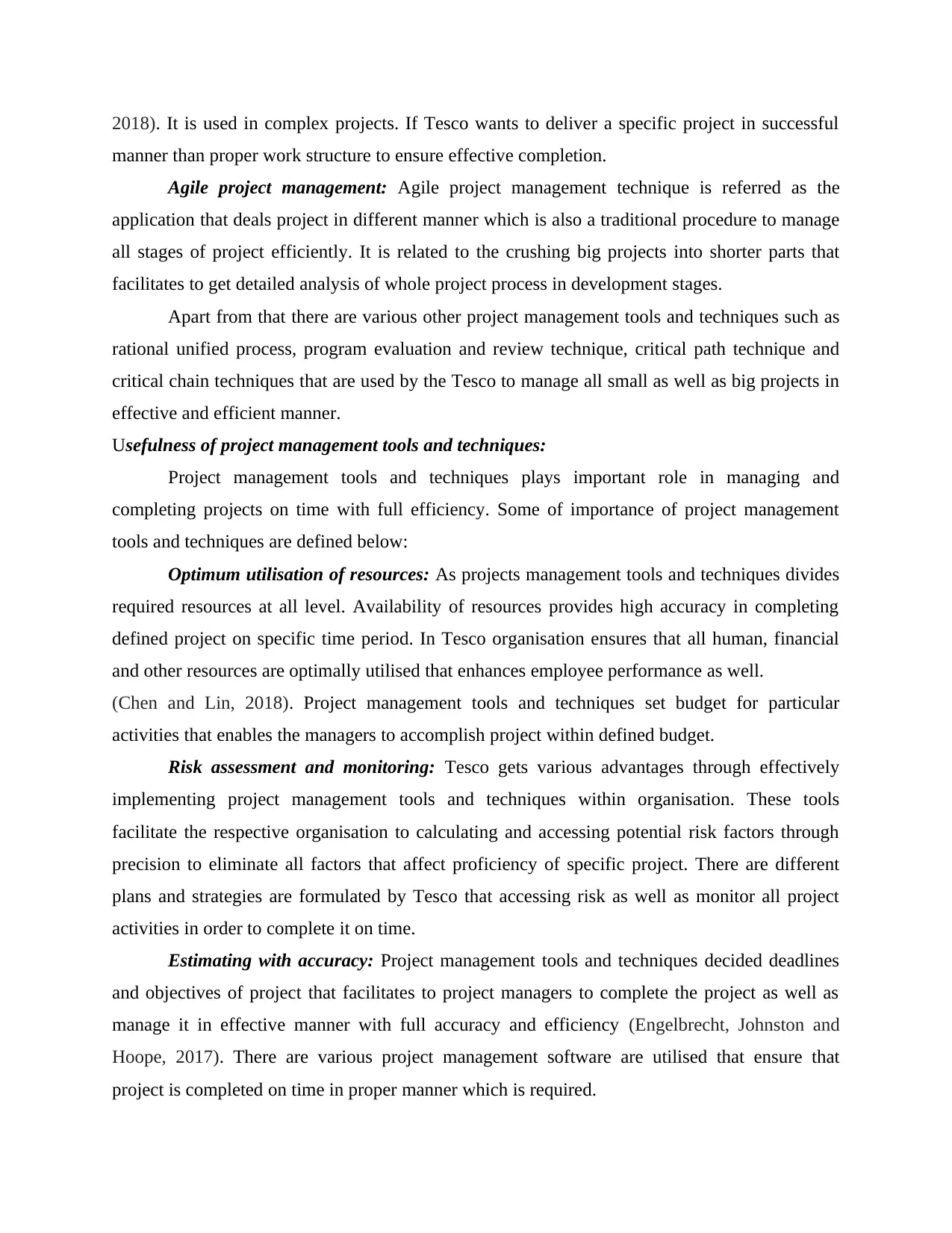
2018). It is used in complex projects. If Tesco wants to deliver a specific project in successful
manner than proper work structure to ensure effective completion.
Agile project management: Agile project management technique is referred as the
application that deals project in different manner which is also a traditional procedure to manage
all stages of project efficiently. It is related to the crushing big projects into shorter parts that
facilitates to get detailed analysis of whole project process in development stages.
Apart from that there are various other project management tools and techniques such as
rational unified process, program evaluation and review technique, critical path technique and
critical chain techniques that are used by the Tesco to manage all small as well as big projects in
effective and efficient manner.
Usefulness of project management tools and techniques:
Project management tools and techniques plays important role in managing and
completing projects on time with full efficiency. Some of importance of project management
tools and techniques are defined below:
Optimum utilisation of resources: As projects management tools and techniques divides
required resources at all level. Availability of resources provides high accuracy in completing
defined project on specific time period. In Tesco organisation ensures that all human, financial
and other resources are optimally utilised that enhances employee performance as well.
(Chen and Lin, 2018). Project management tools and techniques set budget for particular
activities that enables the managers to accomplish project within defined budget.
Risk assessment and monitoring: Tesco gets various advantages through effectively
implementing project management tools and techniques within organisation. These tools
facilitate the respective organisation to calculating and accessing potential risk factors through
precision to eliminate all factors that affect proficiency of specific project. There are different
plans and strategies are formulated by Tesco that accessing risk as well as monitor all project
activities in order to complete it on time.
Estimating with accuracy: Project management tools and techniques decided deadlines
and objectives of project that facilitates to project managers to complete the project as well as
manage it in effective manner with full accuracy and efficiency (Engelbrecht, Johnston and
Hoope, 2017). There are various project management software are utilised that ensure that
project is completed on time in proper manner which is required.
manner than proper work structure to ensure effective completion.
Agile project management: Agile project management technique is referred as the
application that deals project in different manner which is also a traditional procedure to manage
all stages of project efficiently. It is related to the crushing big projects into shorter parts that
facilitates to get detailed analysis of whole project process in development stages.
Apart from that there are various other project management tools and techniques such as
rational unified process, program evaluation and review technique, critical path technique and
critical chain techniques that are used by the Tesco to manage all small as well as big projects in
effective and efficient manner.
Usefulness of project management tools and techniques:
Project management tools and techniques plays important role in managing and
completing projects on time with full efficiency. Some of importance of project management
tools and techniques are defined below:
Optimum utilisation of resources: As projects management tools and techniques divides
required resources at all level. Availability of resources provides high accuracy in completing
defined project on specific time period. In Tesco organisation ensures that all human, financial
and other resources are optimally utilised that enhances employee performance as well.
(Chen and Lin, 2018). Project management tools and techniques set budget for particular
activities that enables the managers to accomplish project within defined budget.
Risk assessment and monitoring: Tesco gets various advantages through effectively
implementing project management tools and techniques within organisation. These tools
facilitate the respective organisation to calculating and accessing potential risk factors through
precision to eliminate all factors that affect proficiency of specific project. There are different
plans and strategies are formulated by Tesco that accessing risk as well as monitor all project
activities in order to complete it on time.
Estimating with accuracy: Project management tools and techniques decided deadlines
and objectives of project that facilitates to project managers to complete the project as well as
manage it in effective manner with full accuracy and efficiency (Engelbrecht, Johnston and
Hoope, 2017). There are various project management software are utilised that ensure that
project is completed on time in proper manner which is required.
Paraphrase This Document
Need a fresh take? Get an instant paraphrase of this document with our AI Paraphraser
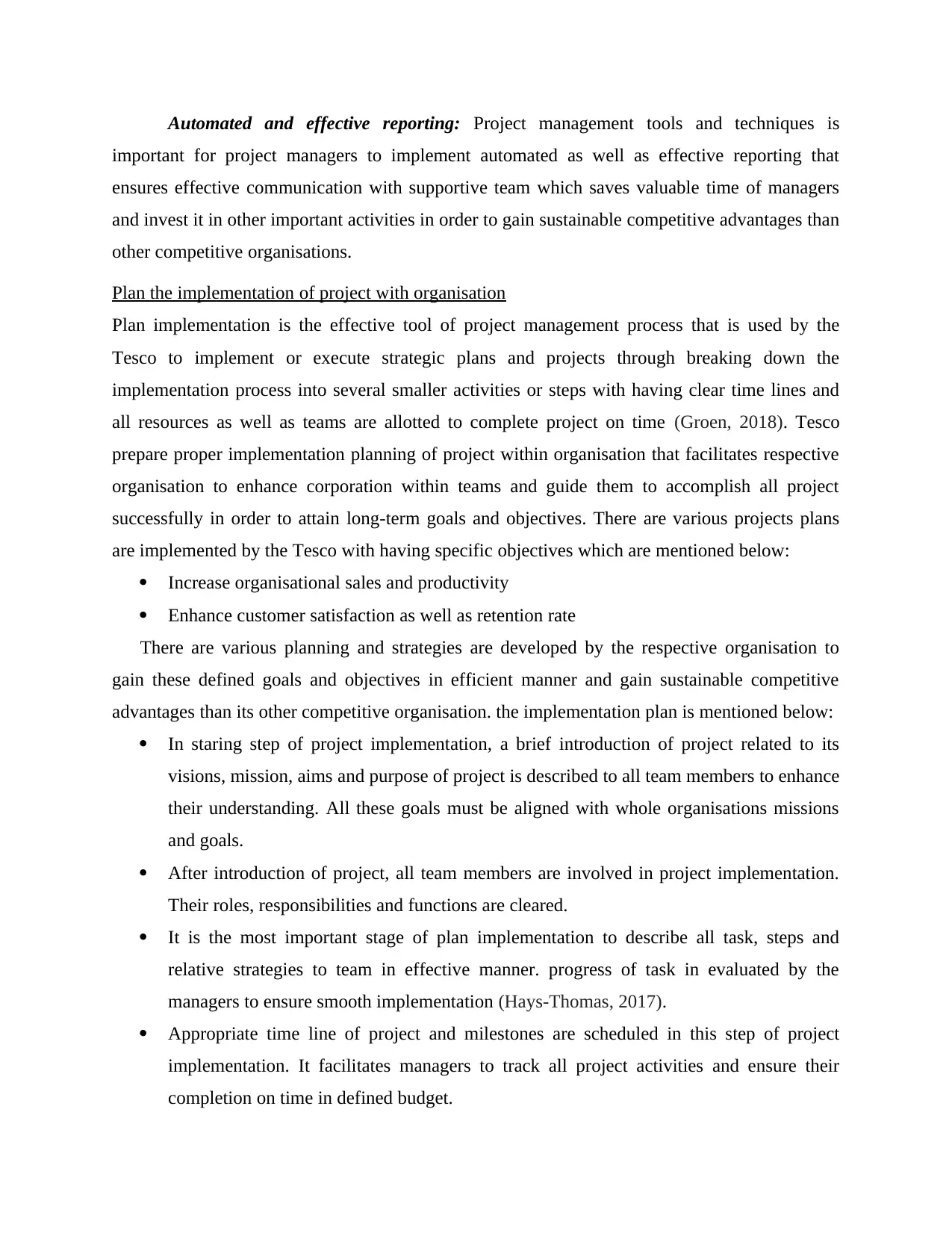
Automated and effective reporting: Project management tools and techniques is
important for project managers to implement automated as well as effective reporting that
ensures effective communication with supportive team which saves valuable time of managers
and invest it in other important activities in order to gain sustainable competitive advantages than
other competitive organisations.
Plan the implementation of project with organisation
Plan implementation is the effective tool of project management process that is used by the
Tesco to implement or execute strategic plans and projects through breaking down the
implementation process into several smaller activities or steps with having clear time lines and
all resources as well as teams are allotted to complete project on time (Groen, 2018). Tesco
prepare proper implementation planning of project within organisation that facilitates respective
organisation to enhance corporation within teams and guide them to accomplish all project
successfully in order to attain long-term goals and objectives. There are various projects plans
are implemented by the Tesco with having specific objectives which are mentioned below:
Increase organisational sales and productivity
Enhance customer satisfaction as well as retention rate
There are various planning and strategies are developed by the respective organisation to
gain these defined goals and objectives in efficient manner and gain sustainable competitive
advantages than its other competitive organisation. the implementation plan is mentioned below:
In staring step of project implementation, a brief introduction of project related to its
visions, mission, aims and purpose of project is described to all team members to enhance
their understanding. All these goals must be aligned with whole organisations missions
and goals.
After introduction of project, all team members are involved in project implementation.
Their roles, responsibilities and functions are cleared.
It is the most important stage of plan implementation to describe all task, steps and
relative strategies to team in effective manner. progress of task in evaluated by the
managers to ensure smooth implementation (Hays-Thomas, 2017).
Appropriate time line of project and milestones are scheduled in this step of project
implementation. It facilitates managers to track all project activities and ensure their
completion on time in defined budget.
important for project managers to implement automated as well as effective reporting that
ensures effective communication with supportive team which saves valuable time of managers
and invest it in other important activities in order to gain sustainable competitive advantages than
other competitive organisations.
Plan the implementation of project with organisation
Plan implementation is the effective tool of project management process that is used by the
Tesco to implement or execute strategic plans and projects through breaking down the
implementation process into several smaller activities or steps with having clear time lines and
all resources as well as teams are allotted to complete project on time (Groen, 2018). Tesco
prepare proper implementation planning of project within organisation that facilitates respective
organisation to enhance corporation within teams and guide them to accomplish all project
successfully in order to attain long-term goals and objectives. There are various projects plans
are implemented by the Tesco with having specific objectives which are mentioned below:
Increase organisational sales and productivity
Enhance customer satisfaction as well as retention rate
There are various planning and strategies are developed by the respective organisation to
gain these defined goals and objectives in efficient manner and gain sustainable competitive
advantages than its other competitive organisation. the implementation plan is mentioned below:
In staring step of project implementation, a brief introduction of project related to its
visions, mission, aims and purpose of project is described to all team members to enhance
their understanding. All these goals must be aligned with whole organisations missions
and goals.
After introduction of project, all team members are involved in project implementation.
Their roles, responsibilities and functions are cleared.
It is the most important stage of plan implementation to describe all task, steps and
relative strategies to team in effective manner. progress of task in evaluated by the
managers to ensure smooth implementation (Hays-Thomas, 2017).
Appropriate time line of project and milestones are scheduled in this step of project
implementation. It facilitates managers to track all project activities and ensure their
completion on time in defined budget.
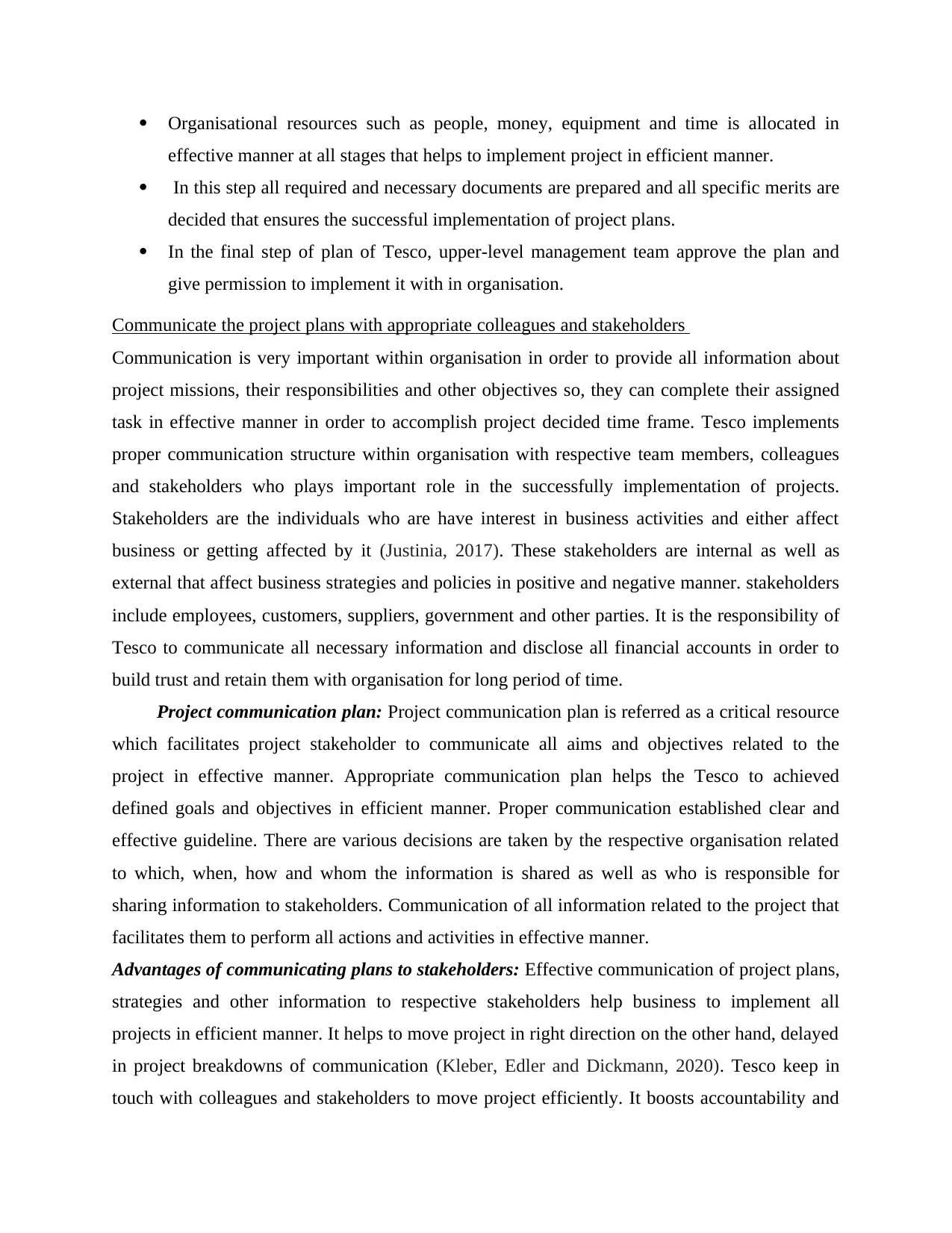
Organisational resources such as people, money, equipment and time is allocated in
effective manner at all stages that helps to implement project in efficient manner.
In this step all required and necessary documents are prepared and all specific merits are
decided that ensures the successful implementation of project plans.
In the final step of plan of Tesco, upper-level management team approve the plan and
give permission to implement it with in organisation.
Communicate the project plans with appropriate colleagues and stakeholders
Communication is very important within organisation in order to provide all information about
project missions, their responsibilities and other objectives so, they can complete their assigned
task in effective manner in order to accomplish project decided time frame. Tesco implements
proper communication structure within organisation with respective team members, colleagues
and stakeholders who plays important role in the successfully implementation of projects.
Stakeholders are the individuals who are have interest in business activities and either affect
business or getting affected by it (Justinia, 2017). These stakeholders are internal as well as
external that affect business strategies and policies in positive and negative manner. stakeholders
include employees, customers, suppliers, government and other parties. It is the responsibility of
Tesco to communicate all necessary information and disclose all financial accounts in order to
build trust and retain them with organisation for long period of time.
Project communication plan: Project communication plan is referred as a critical resource
which facilitates project stakeholder to communicate all aims and objectives related to the
project in effective manner. Appropriate communication plan helps the Tesco to achieved
defined goals and objectives in efficient manner. Proper communication established clear and
effective guideline. There are various decisions are taken by the respective organisation related
to which, when, how and whom the information is shared as well as who is responsible for
sharing information to stakeholders. Communication of all information related to the project that
facilitates them to perform all actions and activities in effective manner.
Advantages of communicating plans to stakeholders: Effective communication of project plans,
strategies and other information to respective stakeholders help business to implement all
projects in efficient manner. It helps to move project in right direction on the other hand, delayed
in project breakdowns of communication (Kleber, Edler and Dickmann, 2020). Tesco keep in
touch with colleagues and stakeholders to move project efficiently. It boosts accountability and
effective manner at all stages that helps to implement project in efficient manner.
In this step all required and necessary documents are prepared and all specific merits are
decided that ensures the successful implementation of project plans.
In the final step of plan of Tesco, upper-level management team approve the plan and
give permission to implement it with in organisation.
Communicate the project plans with appropriate colleagues and stakeholders
Communication is very important within organisation in order to provide all information about
project missions, their responsibilities and other objectives so, they can complete their assigned
task in effective manner in order to accomplish project decided time frame. Tesco implements
proper communication structure within organisation with respective team members, colleagues
and stakeholders who plays important role in the successfully implementation of projects.
Stakeholders are the individuals who are have interest in business activities and either affect
business or getting affected by it (Justinia, 2017). These stakeholders are internal as well as
external that affect business strategies and policies in positive and negative manner. stakeholders
include employees, customers, suppliers, government and other parties. It is the responsibility of
Tesco to communicate all necessary information and disclose all financial accounts in order to
build trust and retain them with organisation for long period of time.
Project communication plan: Project communication plan is referred as a critical resource
which facilitates project stakeholder to communicate all aims and objectives related to the
project in effective manner. Appropriate communication plan helps the Tesco to achieved
defined goals and objectives in efficient manner. Proper communication established clear and
effective guideline. There are various decisions are taken by the respective organisation related
to which, when, how and whom the information is shared as well as who is responsible for
sharing information to stakeholders. Communication of all information related to the project that
facilitates them to perform all actions and activities in effective manner.
Advantages of communicating plans to stakeholders: Effective communication of project plans,
strategies and other information to respective stakeholders help business to implement all
projects in efficient manner. It helps to move project in right direction on the other hand, delayed
in project breakdowns of communication (Kleber, Edler and Dickmann, 2020). Tesco keep in
touch with colleagues and stakeholders to move project efficiently. It boosts accountability and
⊘ This is a preview!⊘
Do you want full access?
Subscribe today to unlock all pages.

Trusted by 1+ million students worldwide
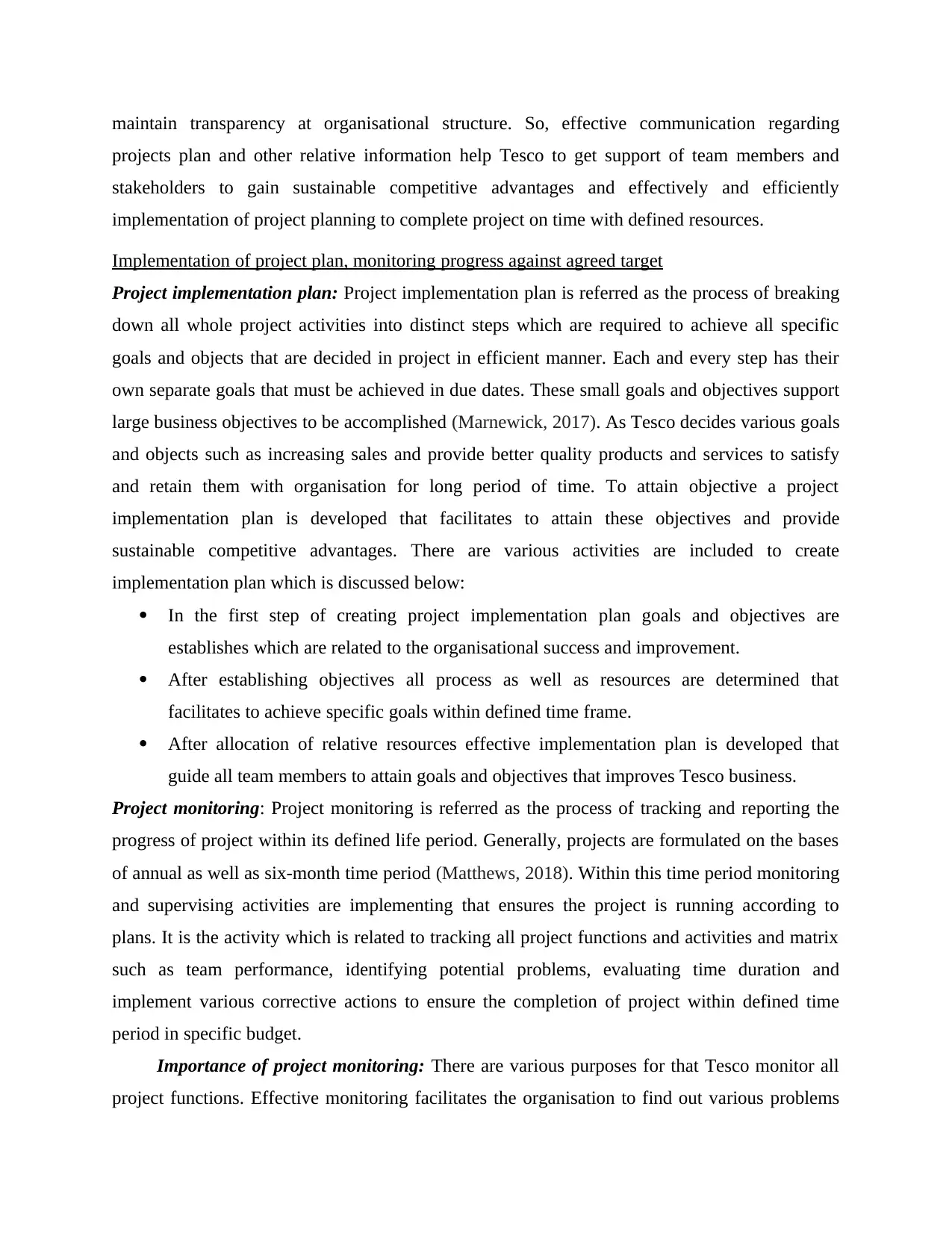
maintain transparency at organisational structure. So, effective communication regarding
projects plan and other relative information help Tesco to get support of team members and
stakeholders to gain sustainable competitive advantages and effectively and efficiently
implementation of project planning to complete project on time with defined resources.
Implementation of project plan, monitoring progress against agreed target
Project implementation plan: Project implementation plan is referred as the process of breaking
down all whole project activities into distinct steps which are required to achieve all specific
goals and objects that are decided in project in efficient manner. Each and every step has their
own separate goals that must be achieved in due dates. These small goals and objectives support
large business objectives to be accomplished (Marnewick, 2017). As Tesco decides various goals
and objects such as increasing sales and provide better quality products and services to satisfy
and retain them with organisation for long period of time. To attain objective a project
implementation plan is developed that facilitates to attain these objectives and provide
sustainable competitive advantages. There are various activities are included to create
implementation plan which is discussed below:
In the first step of creating project implementation plan goals and objectives are
establishes which are related to the organisational success and improvement.
After establishing objectives all process as well as resources are determined that
facilitates to achieve specific goals within defined time frame.
After allocation of relative resources effective implementation plan is developed that
guide all team members to attain goals and objectives that improves Tesco business.
Project monitoring: Project monitoring is referred as the process of tracking and reporting the
progress of project within its defined life period. Generally, projects are formulated on the bases
of annual as well as six-month time period (Matthews, 2018). Within this time period monitoring
and supervising activities are implementing that ensures the project is running according to
plans. It is the activity which is related to tracking all project functions and activities and matrix
such as team performance, identifying potential problems, evaluating time duration and
implement various corrective actions to ensure the completion of project within defined time
period in specific budget.
Importance of project monitoring: There are various purposes for that Tesco monitor all
project functions. Effective monitoring facilitates the organisation to find out various problems
projects plan and other relative information help Tesco to get support of team members and
stakeholders to gain sustainable competitive advantages and effectively and efficiently
implementation of project planning to complete project on time with defined resources.
Implementation of project plan, monitoring progress against agreed target
Project implementation plan: Project implementation plan is referred as the process of breaking
down all whole project activities into distinct steps which are required to achieve all specific
goals and objects that are decided in project in efficient manner. Each and every step has their
own separate goals that must be achieved in due dates. These small goals and objectives support
large business objectives to be accomplished (Marnewick, 2017). As Tesco decides various goals
and objects such as increasing sales and provide better quality products and services to satisfy
and retain them with organisation for long period of time. To attain objective a project
implementation plan is developed that facilitates to attain these objectives and provide
sustainable competitive advantages. There are various activities are included to create
implementation plan which is discussed below:
In the first step of creating project implementation plan goals and objectives are
establishes which are related to the organisational success and improvement.
After establishing objectives all process as well as resources are determined that
facilitates to achieve specific goals within defined time frame.
After allocation of relative resources effective implementation plan is developed that
guide all team members to attain goals and objectives that improves Tesco business.
Project monitoring: Project monitoring is referred as the process of tracking and reporting the
progress of project within its defined life period. Generally, projects are formulated on the bases
of annual as well as six-month time period (Matthews, 2018). Within this time period monitoring
and supervising activities are implementing that ensures the project is running according to
plans. It is the activity which is related to tracking all project functions and activities and matrix
such as team performance, identifying potential problems, evaluating time duration and
implement various corrective actions to ensure the completion of project within defined time
period in specific budget.
Importance of project monitoring: There are various purposes for that Tesco monitor all
project functions. Effective monitoring facilitates the organisation to find out various problems
Paraphrase This Document
Need a fresh take? Get an instant paraphrase of this document with our AI Paraphraser
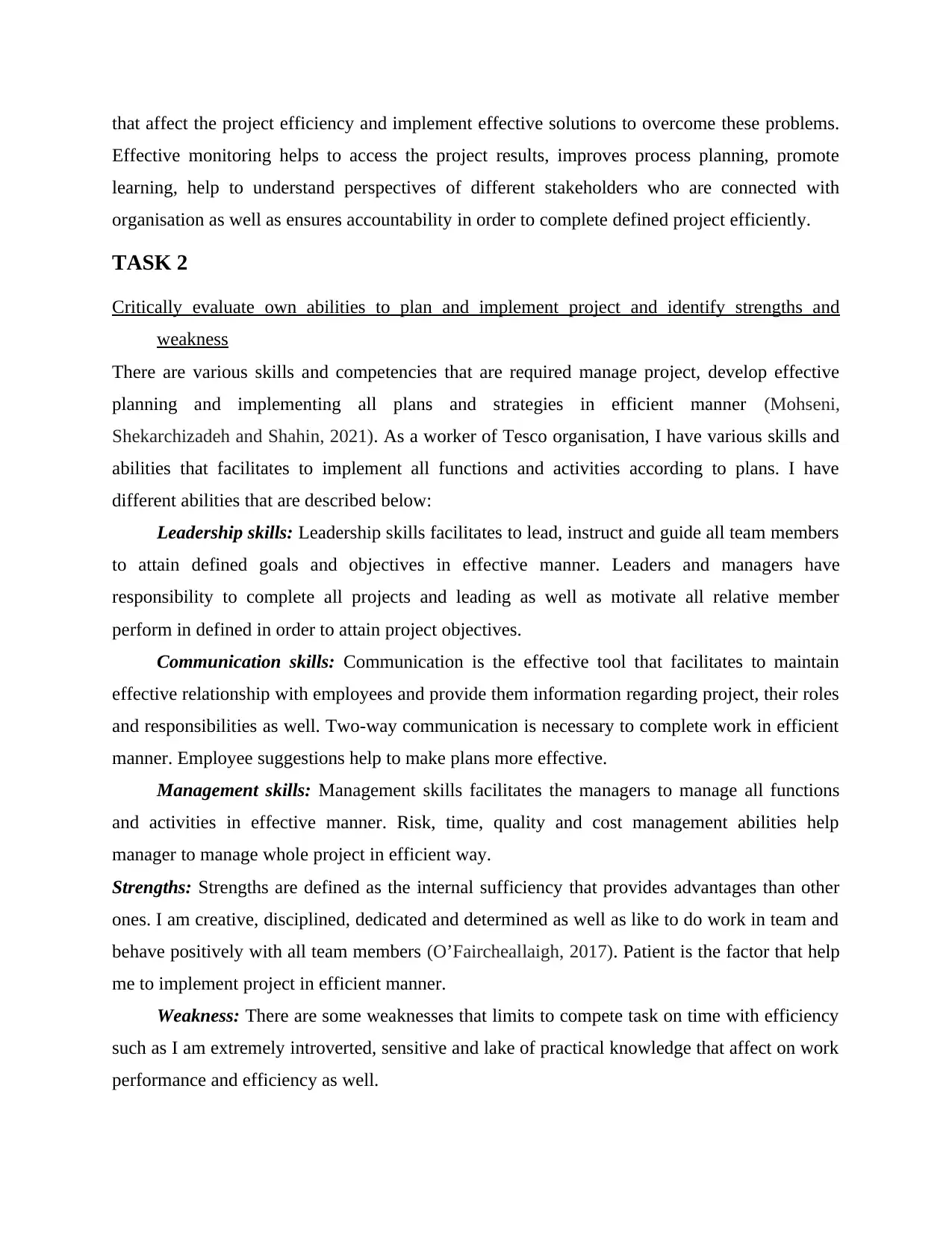
that affect the project efficiency and implement effective solutions to overcome these problems.
Effective monitoring helps to access the project results, improves process planning, promote
learning, help to understand perspectives of different stakeholders who are connected with
organisation as well as ensures accountability in order to complete defined project efficiently.
TASK 2
Critically evaluate own abilities to plan and implement project and identify strengths and
weakness
There are various skills and competencies that are required manage project, develop effective
planning and implementing all plans and strategies in efficient manner (Mohseni,
Shekarchizadeh and Shahin, 2021). As a worker of Tesco organisation, I have various skills and
abilities that facilitates to implement all functions and activities according to plans. I have
different abilities that are described below:
Leadership skills: Leadership skills facilitates to lead, instruct and guide all team members
to attain defined goals and objectives in effective manner. Leaders and managers have
responsibility to complete all projects and leading as well as motivate all relative member
perform in defined in order to attain project objectives.
Communication skills: Communication is the effective tool that facilitates to maintain
effective relationship with employees and provide them information regarding project, their roles
and responsibilities as well. Two-way communication is necessary to complete work in efficient
manner. Employee suggestions help to make plans more effective.
Management skills: Management skills facilitates the managers to manage all functions
and activities in effective manner. Risk, time, quality and cost management abilities help
manager to manage whole project in efficient way.
Strengths: Strengths are defined as the internal sufficiency that provides advantages than other
ones. I am creative, disciplined, dedicated and determined as well as like to do work in team and
behave positively with all team members (O’Faircheallaigh, 2017). Patient is the factor that help
me to implement project in efficient manner.
Weakness: There are some weaknesses that limits to compete task on time with efficiency
such as I am extremely introverted, sensitive and lake of practical knowledge that affect on work
performance and efficiency as well.
Effective monitoring helps to access the project results, improves process planning, promote
learning, help to understand perspectives of different stakeholders who are connected with
organisation as well as ensures accountability in order to complete defined project efficiently.
TASK 2
Critically evaluate own abilities to plan and implement project and identify strengths and
weakness
There are various skills and competencies that are required manage project, develop effective
planning and implementing all plans and strategies in efficient manner (Mohseni,
Shekarchizadeh and Shahin, 2021). As a worker of Tesco organisation, I have various skills and
abilities that facilitates to implement all functions and activities according to plans. I have
different abilities that are described below:
Leadership skills: Leadership skills facilitates to lead, instruct and guide all team members
to attain defined goals and objectives in effective manner. Leaders and managers have
responsibility to complete all projects and leading as well as motivate all relative member
perform in defined in order to attain project objectives.
Communication skills: Communication is the effective tool that facilitates to maintain
effective relationship with employees and provide them information regarding project, their roles
and responsibilities as well. Two-way communication is necessary to complete work in efficient
manner. Employee suggestions help to make plans more effective.
Management skills: Management skills facilitates the managers to manage all functions
and activities in effective manner. Risk, time, quality and cost management abilities help
manager to manage whole project in efficient way.
Strengths: Strengths are defined as the internal sufficiency that provides advantages than other
ones. I am creative, disciplined, dedicated and determined as well as like to do work in team and
behave positively with all team members (O’Faircheallaigh, 2017). Patient is the factor that help
me to implement project in efficient manner.
Weakness: There are some weaknesses that limits to compete task on time with efficiency
such as I am extremely introverted, sensitive and lake of practical knowledge that affect on work
performance and efficiency as well.
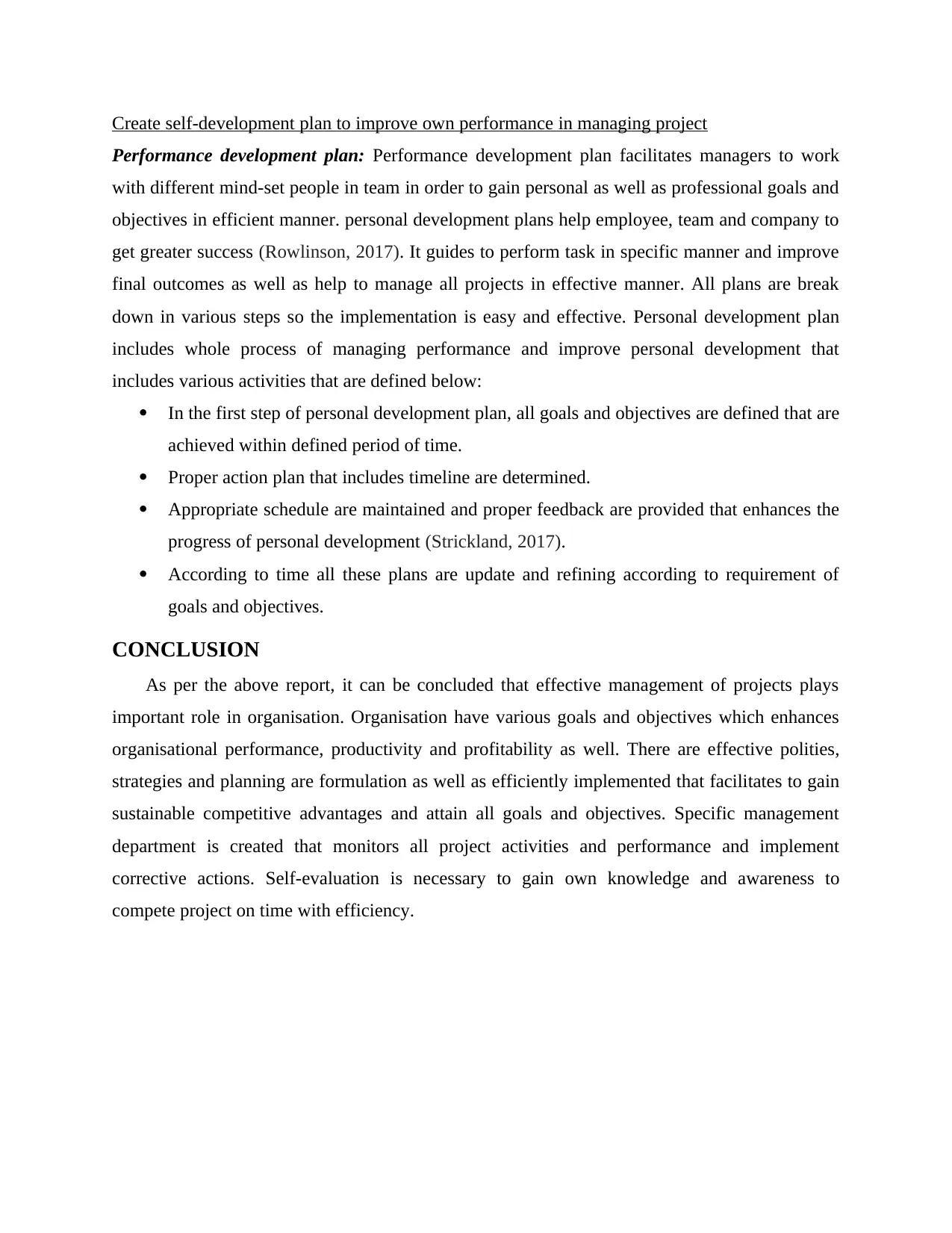
Create self-development plan to improve own performance in managing project
Performance development plan: Performance development plan facilitates managers to work
with different mind-set people in team in order to gain personal as well as professional goals and
objectives in efficient manner. personal development plans help employee, team and company to
get greater success (Rowlinson, 2017). It guides to perform task in specific manner and improve
final outcomes as well as help to manage all projects in effective manner. All plans are break
down in various steps so the implementation is easy and effective. Personal development plan
includes whole process of managing performance and improve personal development that
includes various activities that are defined below:
In the first step of personal development plan, all goals and objectives are defined that are
achieved within defined period of time.
Proper action plan that includes timeline are determined.
Appropriate schedule are maintained and proper feedback are provided that enhances the
progress of personal development (Strickland, 2017).
According to time all these plans are update and refining according to requirement of
goals and objectives.
CONCLUSION
As per the above report, it can be concluded that effective management of projects plays
important role in organisation. Organisation have various goals and objectives which enhances
organisational performance, productivity and profitability as well. There are effective polities,
strategies and planning are formulation as well as efficiently implemented that facilitates to gain
sustainable competitive advantages and attain all goals and objectives. Specific management
department is created that monitors all project activities and performance and implement
corrective actions. Self-evaluation is necessary to gain own knowledge and awareness to
compete project on time with efficiency.
Performance development plan: Performance development plan facilitates managers to work
with different mind-set people in team in order to gain personal as well as professional goals and
objectives in efficient manner. personal development plans help employee, team and company to
get greater success (Rowlinson, 2017). It guides to perform task in specific manner and improve
final outcomes as well as help to manage all projects in effective manner. All plans are break
down in various steps so the implementation is easy and effective. Personal development plan
includes whole process of managing performance and improve personal development that
includes various activities that are defined below:
In the first step of personal development plan, all goals and objectives are defined that are
achieved within defined period of time.
Proper action plan that includes timeline are determined.
Appropriate schedule are maintained and proper feedback are provided that enhances the
progress of personal development (Strickland, 2017).
According to time all these plans are update and refining according to requirement of
goals and objectives.
CONCLUSION
As per the above report, it can be concluded that effective management of projects plays
important role in organisation. Organisation have various goals and objectives which enhances
organisational performance, productivity and profitability as well. There are effective polities,
strategies and planning are formulation as well as efficiently implemented that facilitates to gain
sustainable competitive advantages and attain all goals and objectives. Specific management
department is created that monitors all project activities and performance and implement
corrective actions. Self-evaluation is necessary to gain own knowledge and awareness to
compete project on time with efficiency.
⊘ This is a preview!⊘
Do you want full access?
Subscribe today to unlock all pages.

Trusted by 1+ million students worldwide
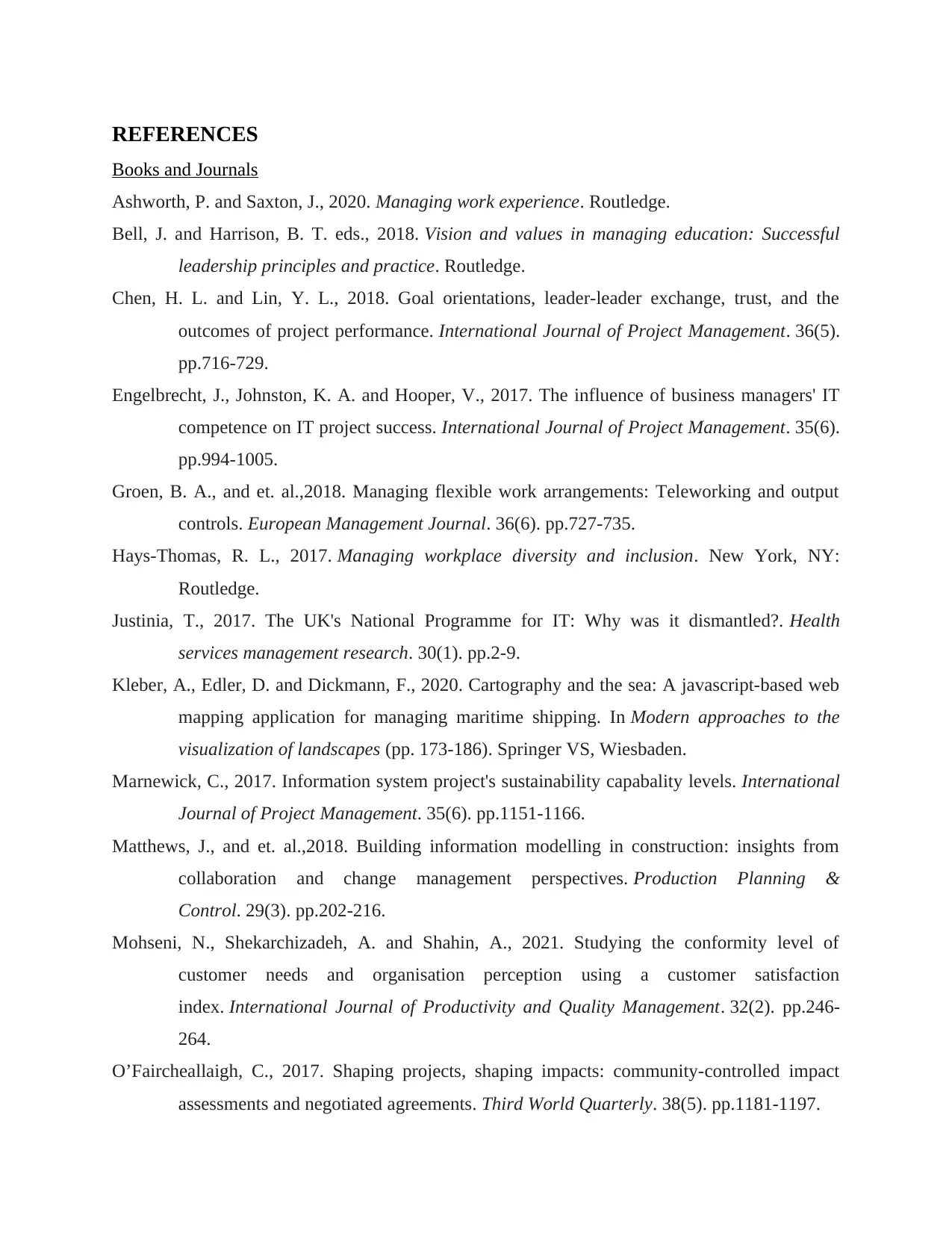
REFERENCES
Books and Journals
Ashworth, P. and Saxton, J., 2020. Managing work experience. Routledge.
Bell, J. and Harrison, B. T. eds., 2018. Vision and values in managing education: Successful
leadership principles and practice. Routledge.
Chen, H. L. and Lin, Y. L., 2018. Goal orientations, leader-leader exchange, trust, and the
outcomes of project performance. International Journal of Project Management. 36(5).
pp.716-729.
Engelbrecht, J., Johnston, K. A. and Hooper, V., 2017. The influence of business managers' IT
competence on IT project success. International Journal of Project Management. 35(6).
pp.994-1005.
Groen, B. A., and et. al.,2018. Managing flexible work arrangements: Teleworking and output
controls. European Management Journal. 36(6). pp.727-735.
Hays-Thomas, R. L., 2017. Managing workplace diversity and inclusion. New York, NY:
Routledge.
Justinia, T., 2017. The UK's National Programme for IT: Why was it dismantled?. Health
services management research. 30(1). pp.2-9.
Kleber, A., Edler, D. and Dickmann, F., 2020. Cartography and the sea: A javascript-based web
mapping application for managing maritime shipping. In Modern approaches to the
visualization of landscapes (pp. 173-186). Springer VS, Wiesbaden.
Marnewick, C., 2017. Information system project's sustainability capabality levels. International
Journal of Project Management. 35(6). pp.1151-1166.
Matthews, J., and et. al.,2018. Building information modelling in construction: insights from
collaboration and change management perspectives. Production Planning &
Control. 29(3). pp.202-216.
Mohseni, N., Shekarchizadeh, A. and Shahin, A., 2021. Studying the conformity level of
customer needs and organisation perception using a customer satisfaction
index. International Journal of Productivity and Quality Management. 32(2). pp.246-
264.
O’Faircheallaigh, C., 2017. Shaping projects, shaping impacts: community-controlled impact
assessments and negotiated agreements. Third World Quarterly. 38(5). pp.1181-1197.
Books and Journals
Ashworth, P. and Saxton, J., 2020. Managing work experience. Routledge.
Bell, J. and Harrison, B. T. eds., 2018. Vision and values in managing education: Successful
leadership principles and practice. Routledge.
Chen, H. L. and Lin, Y. L., 2018. Goal orientations, leader-leader exchange, trust, and the
outcomes of project performance. International Journal of Project Management. 36(5).
pp.716-729.
Engelbrecht, J., Johnston, K. A. and Hooper, V., 2017. The influence of business managers' IT
competence on IT project success. International Journal of Project Management. 35(6).
pp.994-1005.
Groen, B. A., and et. al.,2018. Managing flexible work arrangements: Teleworking and output
controls. European Management Journal. 36(6). pp.727-735.
Hays-Thomas, R. L., 2017. Managing workplace diversity and inclusion. New York, NY:
Routledge.
Justinia, T., 2017. The UK's National Programme for IT: Why was it dismantled?. Health
services management research. 30(1). pp.2-9.
Kleber, A., Edler, D. and Dickmann, F., 2020. Cartography and the sea: A javascript-based web
mapping application for managing maritime shipping. In Modern approaches to the
visualization of landscapes (pp. 173-186). Springer VS, Wiesbaden.
Marnewick, C., 2017. Information system project's sustainability capabality levels. International
Journal of Project Management. 35(6). pp.1151-1166.
Matthews, J., and et. al.,2018. Building information modelling in construction: insights from
collaboration and change management perspectives. Production Planning &
Control. 29(3). pp.202-216.
Mohseni, N., Shekarchizadeh, A. and Shahin, A., 2021. Studying the conformity level of
customer needs and organisation perception using a customer satisfaction
index. International Journal of Productivity and Quality Management. 32(2). pp.246-
264.
O’Faircheallaigh, C., 2017. Shaping projects, shaping impacts: community-controlled impact
assessments and negotiated agreements. Third World Quarterly. 38(5). pp.1181-1197.
Paraphrase This Document
Need a fresh take? Get an instant paraphrase of this document with our AI Paraphraser

Rowlinson, S., 2017. Building information modelling, integrated project delivery and all
that. Construction Innovation.
Strickland, J., 2017. Organisation and objectives. The International Business Archives
Handbook: Understanding and Managing the Historical Records of Business. pp.151-
173.
that. Construction Innovation.
Strickland, J., 2017. Organisation and objectives. The International Business Archives
Handbook: Understanding and Managing the Historical Records of Business. pp.151-
173.

⊘ This is a preview!⊘
Do you want full access?
Subscribe today to unlock all pages.

Trusted by 1+ million students worldwide
1 out of 12
Related Documents
Your All-in-One AI-Powered Toolkit for Academic Success.
+13062052269
info@desklib.com
Available 24*7 on WhatsApp / Email
![[object Object]](/_next/static/media/star-bottom.7253800d.svg)
Unlock your academic potential
Copyright © 2020–2025 A2Z Services. All Rights Reserved. Developed and managed by ZUCOL.



